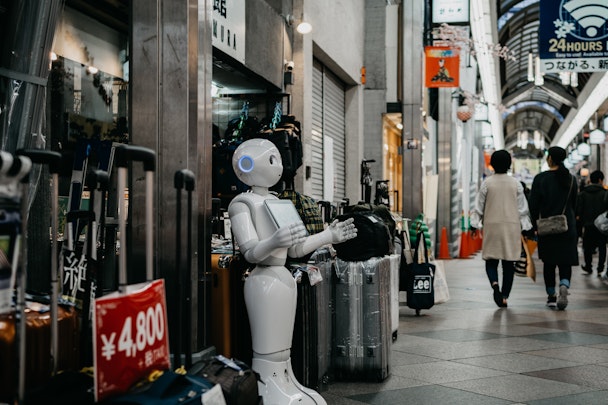I became an accidental AI expert – here’s how it’s already useful for advertisers
Emily Clements of Radley Yeldar is a filmmaker by trade who became an accidental AI expert last year. Here’s where she’s seen the tech being actually useful to marketers (rather than just shiny and new).

AI: already useful now, but how? / Lukas via Unsplash
In 2023, the once-niche world of AI transformed from a buzzword of something sprawling, complicated and understood only by specialists into a force accessible to millions of people worldwide. There’s been a lot of noise around AI, created not only by the accelerated sophistication of generative AI but also the introduction of user-friendly interfaces exemplified by platforms like ChatGPT. None of us could resist having a play.
For someone who initially avoided the complexities of AI, I've gone on a journey from ostrich to optimist (with a small dose of terror mixed in there, somewhere around mid-summer). This was all fuelled by enthusiasm for the immense potential this technology brings.
Advertisement
Too fast too soon?
Along the way, I’ve found there are three distinct buckets that AI seems to fall into.
First, there’s the good: healthcare advancements, education enhancement, environmental conservation, and humanitarian aid and disaster response.
Then, the bad: surveillance, job displacement, and biased decision-making.
Finally, the downright ugly: weaponization, deepfakes, misinformation, and social manipulation.
Across these cases, it’s the speed of adoption and evolution that’s having the most impact. That’s what’s forcing us to run at pace to understand and make best use of its creative potential. Indeed, AI is expanding possibilities in almost every sector, and ours is no different.
The one thing that does set us apart in this industry is that, as creatives, it’s not in our nature to sit back and let things happen around us. We just can’t help getting stuck in to push the boundaries.
Advertisement
What AI is useful for, already
Last summer, when I was faced with the task of presenting on AI’s impact on film and animation at the Cannes Corporate Film and TV Festival, I thought about the generative AI tools that have been most effective when built into our workflows. Tools for translation, rotoscoping, and color balancing have proven immediately useful. Others (such as generative tools for film like Full Journey) are a little further off.
What unites these diverse tools and use cases is the pace at which they’re developing; it’s helpful to get on the front foot of them so that we can keep testing, learning and using them where it’s appropriate.
Suggested newsletters for you
But we’re also seeing that there are very different entry points in terms of knowledge and ambition to embrace these tools (even within the same organizations, at times). Some clients are quite far ahead with exploring and deploying generative AI tools, to the extent that we’re asked to supply animation toolkits to interface with their tools. Others are much more risk averse, with their legal and brand teams exploring the risks and opportunities in a deeper way.
The things that AI is good at already, today, broadly fit into four categories:
-
Organization – from interrogating information and organizing data to reframing problems, AI helps us get our houses in order in a methodical way.
-
Exploration – generating ideas, acting as a sounding board, and aiding experimentation is enhancing our creative output, not dictating it.
-
Streamlining – rotoscoping, translations, and image backfilling is an exercise in increasing efficiency.
-
Optimzing – asset repurposing, deployment guidance, and workflow automation all finetune the process from start to finish.
What’s most important, though, is that we continue on this journey in 2024 with a healthy dose of human oversight. AI is very good at coming up with compelling sounding nonsense, so we need to ensure that we’re maintaining quality, using it to support our craft and creativity (rather than substituting for it). We must leverage our skills and judgment to navigate when, where, and how to use it, taking ethical considerations into account and using only the most fitting tools for each task. In doing so, we ensure that AI becomes a harmonious extension of our creative endeavors, rather than a force that dictates them.
Content by The Drum Network member:

Radley Yeldar
Radley Yeldar is an award-winning, independent, London and Birmingham-based creative consultancy. Our 200-strong team of specialists has been helping to create a...
Find out more
